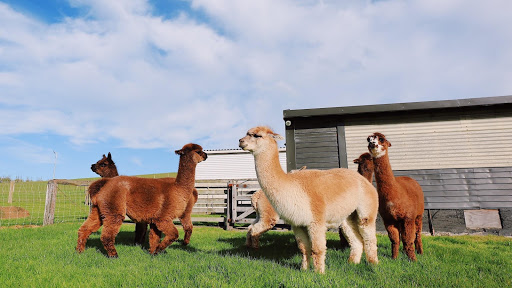By ANNE HOOPER
Capital News Service
LANSING — When we hear the word “farming” we typically envision pastures dotted with cattle, muddy pens full of pigs or hen houses bustling with chickens.
But there is a new animal in the Great Lakes spotlight: the alpaca. While far less common than other livestock, the wooly Peruvian quadruped is crucial for the livelihood of some American farmers.
This is especially true for the Great Lakes region, where some of the nation’s largest registered alpaca herds are found.
“Out of all the different animals that we’ve farmed — which includes cattle, pigs and horses — alpacas have been our favorite,” said Nancy Rogers, of Mount Pleasant. They’re clean, have docile personalities and are a dual-purpose animal: You can breed and sell them while harvesting their fiber,” she said.
Rogers owns Three Generations of Love, an alpaca farm that she founded with her mother several years ago.
In both the Great Lakes region and country, Ohio takes first place with 26,512 registered alpacas, according to the Alpaca Owners Association—a national organization headquartered in Lincoln, Nebraska.
The association reports there are 16,840 alpacas in New York, 13,501 in Pennsylvania, 8,302 alpacas in Michigan, 7,927 in Wisconsin and 5,073 in Indiana.
As the industry has developed, so have related organizations — such as the Great Lakes Alpaca Association headquartered in Lodi, Wisconsin. Founded in 1995, its mission is “to promote the growth of the alpaca industry” in the region.
Alpaca wool is becoming a hot commodity worldwide. Over the next decade, the fiber’s global market is predicted to experience a compound annual growth rate of 5%, according to Visiongain’s Alpaca Fiber Market Report 2020-2030.
Visiongain attributes this growth to increased demand for the fiber, which has become globally popular due to its environmental-friendliness.
Many natural and synthetic materials are environmentally destructive to produce. Cashmere goats, for instance, eviscerate their grazing land with their sharp hooves.
Manufacturing synthetic textiles uses precious resources while pumping out harmful chemicals.
Alpaca wool could help mitigate pollution, experts say.
The animal is renowned for its soft hooves that leave grazing land unscathed. It also requires minimal water and produces little waste compared to other livestock, such as sheep and cattle.

Rogers attests to their cleanliness: “They have padded feet that don’t tear up the pastures. They also use a concentrated dung pile where the whole herd excretes their waste.”
“Their feces are small and pelletlike, making them easy to collect for disposal or use as compost. And, since alpaca waste contains low levels of nitrogen, it’s safe to put back into the environment,” she said.
Rogers said they sold their herd following her mother’s retirement in 2016. Although the animals have left Three Generations, a constant reminder of them remains: their wool.
“With the alpacas gone, we’re solely in the business of fiber production now. We’ve accumulated a lot of wool from them, which we take to the local mill and convert into yarn,” Rogers said.
“It generally costs $8-$10 to make a skein of yarn, which then sells for $15-$20. Most of our money, though, comes from our knitted apparel. People prefer to buy clothing rather than making it themselves,” she said.
Rogers said that the largest profit comes from completed apparel and accessories.
It can be hard to break into the industry because of the several-thousand-dollar price for each animal and the relatively low revenue of raw fiber — though well-established, sizable farms can become financially sustainable, according to AARP, the national association for retirees. The most profitable are those that can carry out production from start to finish, beginning with raw fleece and ending with artisan clothing, said the organization.
According to economists, alpaca wool is valued at about $25 per kilo (2.2 pounds) in the global marketplace — that’s six times the price of standard sheep wool.
Aside from producing wool and fertilizer, the animal itself is innately valuable. Since alpacas were first introduced to the United States in 1984, demand has grown dramatically each year.
“When alpacas were first brought here from Peru in the 1980s, there were just a few of them and they cost a fortune,” said Leslie Herzog, president of the Great Lakes Alpaca Association. “If you could trace your alpaca’s lineage to the Peruvian Acoya Farm, you could make well over $100,000.”
Along with being the association’s president, she owns and operates Herzog Alpacas in Highland Park, Illinois. She’s witnessed the evolution of the American alpaca industry over the past several years.
“Since alpacas were so valuable back then, people’s primary focus was buying and selling them — they weren’t as interested in their fleece. That all changed, though, when the recession hit in 2008 and alpaca farmers were no longer able to sustain themselves by selling the animals,” Herzog said.
“But, instead of dying out, the industry reinvented itself and began to reorient itself toward cultivating and selling the animal’s fiber. It’s warmer than wool, hypoallergenic, water-repellent and environmentally friendly. People love it,” she said.
According to Herzog, alpaca cultivation is on the rise. For the industry to reach its full potential, however, she said better fiber mills need to be constructed.
“While Peru has lots of specialized mills that can accommodate alpaca fiber, we have relatively few that can process it. At this point in time, the amount of mills that we have couldn’t handle a large-scale, thriving alpaca industry,” she said.
While the lack of large-scale mills currently presents an obstacle for the industry’s advancement, Herzog said she’s optimistic about its future in the Great Lakes region and beyond.
“We’re just tapping into the potential of alpaca fiber. Even with the current industry limitations, we’re refining it, blending it with other materials and finding new purposes for it — that fiber is the future,” she said.